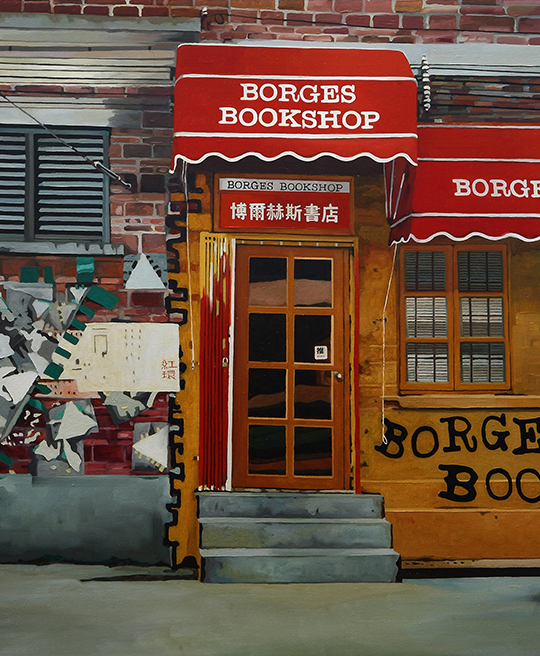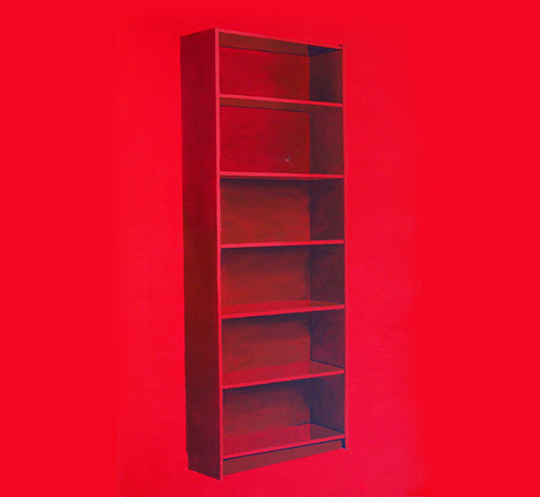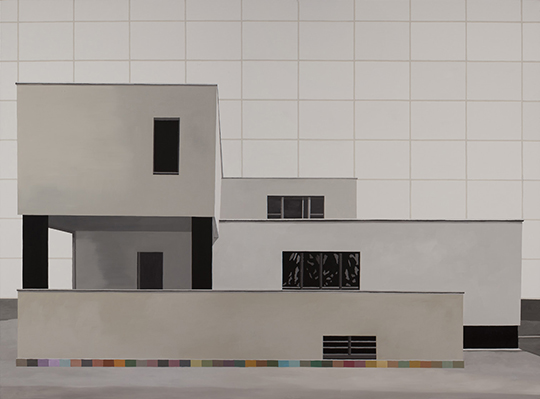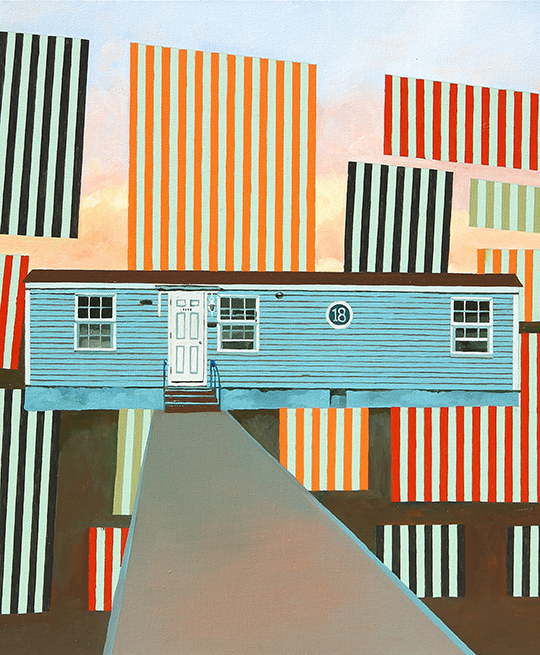AN IMAGINED MAN: CHEN TONG
| December 31, 2015 | Post In LEAP 35

1
No matter how you approach him—whether in the imagination, in memory, or in reality—he still seems like an island in the sea: a little dot floating as if at home in an eternally turbulent world. Can I say this? To check, I replay them in my mind, over and over again—all of the real and imagined moments I have of him from 20 years of knowing him. Yes, he is like that. And yet, he is not; my analogy does not cover everything. I must extend the scope of the scene—he is a free-spirited ocean pioneer out on uncharted waters during the Age of Discovery, at the helm of his brigantine. Under the aegis of Libra above, he moves ever-forward through the sudden storms and sudden silences of the open sea, lucky not to be ripped to shreds by a hurricane. But there is more; he has come upon an island rich with natural resources. He has built his home there, settling the virgin soil and discovering all kinds of new species of plants and animals. He is not Defoe’s Robinson Crusoe, a survivor of a shipwreck trying to civilize his man Friday and establish order on an uninhabited island, eager to return to the civilization of the mainland. No, he was never so well equipped, so commanding as an adventurer, nor was he a new world colonist absorbed by fame and fortune. He was there instead to follow his curiosity, little by little, on this island he had discovered by chance and had come to love as his own world. Patiently he built the roads and gradually invited kindred souls. Bit by bit, he brought things from the island back to the mainland. Would he agree with this way of putting it? Maybe he would adopt that familiar, somewhat aloof expression, squint out at some point in the distance, a little tickled by the randomness of it, and then half-jokingly remark that he would rather go to Réunion Island in the Indian Ocean, not some desert island. They have everything there, and you don’t have to discover anything. You have time to relax, and all you have to do is lie in the bright sunlight outside of your hotel on a white lounge chair, straw sun hat on your head, looking at the volcano in the distance: alive, but, for now, silent.
2
“Don’t worry about it. In a place like this, this is just the way it is.” It is May, 2010, and we are in the ground floor restaurant of an old hotel in Shanghai. We have waited over half an hour for our food to arrive, only to find ourselves presented with flavorless little snacks when it finally does. On a nearby street corner a few people are arguing. Chen Tong isn’t bothered by any of it. He doesn’t sweat the small stuff, and it’s hard to believe the tolerance he possesses because it seems he almost never gets caught up with the trivial interpersonal entanglements of daily life. He is more concerned with the progress of the things that truly matter to him. On this night he is in a very talkative mood as he shares his feelings on interconnectedness. For him, every person and every thing he has come across in life can be included in a network. Rather than fragmenting life into isolated issues and phenomena he builds a whole, seeing how the parts link to one other. “No matter how many things there are, they are all part of one thing.” At some point the discussion naturally turns to the topic of reading books. He reminds a friend visiting from the north, who bought several books during the day, “Don’t become a book consumer.” In his view, hurriedly reading through many books in a short period of time is consumer reading; it has no benefits. He advocates reading slowly—perhaps reading only a few books a year, and reading one or two of them over again. Later, as the conversation drifts to idle chat about a mutual friend making a breakthrough in performance circles, he becomes lost in his own thoughts, not commenting. He rarely gossips or ridicules people, and he does not like it when others do so casually. He advises his northern friend, skilled at calligraphy, to write a piece for an enthusiast buddy of his when he gets home, and suggests Mao Zedong’s “Kunlun Mountain” for its content. He recites from memory, forgetting some lines in the middle: “Over the earth / the green-blue monster Kunlun who has seen / all spring color and passion of men. / Three million dragons of white jade soar / and freeze the whole sky with snow. / When a summer sun heats the globe / rivers flood / and men turn into fish and turtles. / Who can judge / a thousand years of accomplishments or failures? / … / that the world have peace / and the globe share the same heat and ice.” He feels the poem reflects the author’s complexity of feeling: many layers of meaning that, when considered, are of great interest. Everyone at the table has fallen silent.

3
It is another night three or four years ago, and Chen Tong has come to Shanghai for an exhibition opening. Later I accompany him to another opening dinner at Three on the Bund. When the curator announces that Chen has arrived, everyone bursts into enthusiastic applause: genuine applause, not just a courtesy. I stand off to the side and watch his uncomplicated “hellos” as he holds each outstretched hand. I know that, in this kind of environment, ordinarily filled with hypocrisy and empty talk, the shift to something authentic in Chen’s presence is because of the Libreria Borges; or his experimental art book series; or his Midnight publication series; his simple yet intimate connections to French nouveau roman, Les Éditions de Minuit (the Midnight Press), French writers Alain Robbe-Grillet, Jean Echenoz, and Jean-Philippe Toussaint; or of course his unique position in and mode of interaction with Chinese contemporary art. To be honest, this scenario is rare in China: amid a complex atmosphere, the purity of his own endeavor is clear. It is a rare cultural phenomenon or art act that does not draw ridicule but rather uniformly commands respect. For a long time now it has been the case that, when people in literary and artistic circles visit Guangzhou, they go to the Libreria Borges, where the only books on offer are those rare ones that appeal to the interests of the boss. More or less all of them will buy a few books and then quietly leave: proof that, even in a domestic environment where hostility pervades, when people see before them a thing of real value it is not hard to reach a consensus. Perhaps some of these fans are like I was 20 years ago: you happen on a corner advertisement in Dushu, see the phone number and address of the bookstore, get in touch with and maybe even get to meet Chen Tong. Later you start regularly receiving the catalog of new books and the informal publication he edits, L. Occasionally you follow the youthful urge to call him up long-distance without quite knowing what you’re going to say. At the time you have no idea he can write, or that he is a teacher at the Guangzhou Academy of Fine Arts, or that he is trained as a classical Chinese painter himself; you do not know that he can draw comics and picture-books and greatly admires He Youzhi, or that he has researched Hao Ran’s The Golden Road. You do not know that he cannot, in fact, speak French, but that with the help of a French dictionary he once wrote Jérôme Lindon and Alain Robbe-Grillet a letter and from there slowly pushed open that mysterious, off-beat door to French literature that is Minuit.

4
“Chen Tong is probably one of contemporary China’s best essayists,” our friend Lu Yi says with great certainty. I agree with him. But, except for us, I don’t know who else would say so. Even those friends who are on very familiar terms with Chen and know he can write don’t necessarily realize the level he has achieved in his writing—not to mention those who don’t know him at all. In the eyes of most, Chen may always remain the Borges bookstore owner, the Midnight publisher, the ink painter, or the perpetually shape-shifting art activist alternating among all of the above. He may even remain Chen Xiangyang, that Cantonese-speaking guy from Hunan. But in a certain sense, if you do not understand the worth of Chen’s writings, you cannot possibly enter his world. As an adherent of Robbe-Gillet, Chen’s ideas and style have benefited from the Romanesques series. We can see it in his style: the sense of calm; the words so substantive and filled with purpose yet concealing hidden wisdom; the simplicity; the emphasis on exactness, rhythmic control, and hierarchical structure. In one essay he puts it this way: “With writing, my attitude is more serious than with painting. Writing for me is where the real challenge appears. It presents itself not just in the demands of weaving together sentences, but also and more so in the difficulty of mining the thought itself—in the necessary depth and criticality it requires. I have been provoked by new fiction to accept the obstacles of reading, and now writing is my only means of overcoming my recklessness in painting…in this way writing has become art; in fact it cannot possibly be, nor should it be, anything other than that. (In contrast, I still maintain that to a certain degree painting is actually the medium that spends more time in the category of utility. The difference is, it is often concealed in the language and form of art.) If the difficulty of painting comes from our putting it on a pedestal, then the difficulty of writing lies precisely in the rigor of the work itself, the work of conceiving of it and structuring it. Furthermore, with writing, the pleasure it provides takes different forms for different people. So the work is in thoroughly capturing the reader’s perception.” He rarely talks about writing with us, and even more rarely expresses his opinions about our work. Perhaps as far as he is concerned, to have a serious attitude does not necessarily mean to take it all so seriously. Interestingly enough, as I talk with Lu Yi about Chen’s writing, Chen himself is far away from us on a farm in the north of Heilongjiang. He is taking an assistant around, shooting footage for a short film that will be only a few minutes long and include two characters and one line of dialogue. And all that brought him out there was his search for an old-fashioned combine harvester.
5
He enjoys hopping from place to place in a kind of seamless flow state. He will fly to Beijing in the afternoon to attend an event, and at noon the next day fly to Shanghai to participate in an academic symposium at an art institution, only to fly back to Guangzhou in the middle of the night, paint until four in the morning, and head to GAFA at eight to write a lesson for his students. He enjoys keeping everything continuous and nonstop, while always holding the reins. Most people can’t comprehend how he does it—he has so much to do and yet he is still so full of enthusiasm rushing to school to teach his students and take them out sketching. The answer can perhaps be found in the example of his beloved Robbe-Grillet: always curious, always in love with learning, and always living life hands-on. He likes to play the lecturer just as he likes to rise to all art. “When they go east, I don’t go west: I go south.” He likes when life and work are constantly flowing into each other and evolving, never static or rigidly divided. “My multiple identities and projected images are formed in constant violation of economically principled space; this is why my reputation as a social activist spreads out farther and farther. But left at that, people would not agree that this constitutes a social/artistic practice because there is no ‘tangible’ work. Accordingly, in order to restore the artistic nature to the practice, I integrate my various identities and view all behavior as part of the work. If traditional definitions of art are unable to accept this, then surely contemporary art’s openness will be willing to open the door. Contemporary art, in order to distinguish itself from traditional art, does its best to co-opt all things, not paying attention to their structure or life span within the socioeconomic framework. So it is in this way that the parts of my practice that occur in space, in spite of their place in a far-off reality in the clouds, have still enjoyed sunlight… I just do my own thing—that is to say that what I do can all be done with my name on it—and no matter how many different things they are it is all one thing, and this thing is ‘art’.”

6
I have known Chen Tong for 20 years, and yet most of the time he is more like an imaginary figure to me. Our limited encounters each year do not pull me out of the joys of this feeling, into reality, but rather serve to further intensify the magic. Indeed, everything he does further proves him to be the kind of person who makes you want to imagine. One time, he took a group of students to the countryside to paint. A Shandong radio station called him for an interview, so he found a small shop in the village with a public telephone outside of it, and stood in that spot for six hours, talking to the radio host. Years later he took me to the same village, and through the car window he pointed to that spot, where he had taken that phone call. It was completely different than what I had remembered. In my imagination I had filled out the entire space with all of these tiny, nuanced changes that had occurred in this environment over the course of those six long hours. Then there was another time, in the early days of the Midnight series, when he said he was planning on including a new work by Robert Pinget. One night, in the office of Libreria Borges, I glimpsed in a half-opened drawer some of the proofs. As I waited expectantly for the publication to come out, I daydreamed about the writing. I imagined the smell of Pinget’s words, the temperature and the rhythm of them. Over time it became as if I knew the whole piece—a piece I had not even read yet—by heart. Or there was the time, before one of his trips to Réunion, when Chen Tong called me from the airport departures lounge. We talked on the phone for a long while, mostly about what was going on in his life at the time. I cannot remember any details from that conversation. What I do remember, most clearly, is his casual mention of a book of his own that he might write while staying on the island. It would not be very long, more like a diary, and maybe it would have some sketches scattered throughout. Or it might be something completely different. He didn’t know. He said he was considering the name Silent Volcano. And so, for over two years since that conversation, I looked forward to this book, in my imagination constantly filling it with what it might contain: my own imaginary contents, even my own imaginary versions of those sketches. Until at last, when I saw it in print, it was an entirely different Silent Volcano than the one I had created. Perhaps in this sense, what I have shared here is only the Chen Tong of my own imagination. (Translated by Katy Pinke)

